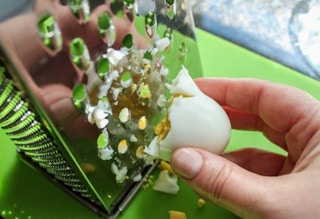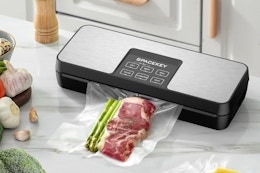Anyone who enjoys cooking probably has, or at least knows of, a cheese grater. It was invented more than 400 years ago to shred cheese—but it’s handy for prepping more than just that. Check it out:
First, a few tips on caring for your grater.

- To avoid a messy clean cleanup, spray your grater with cooking spray before each use.
- Clean it as soon as you’re done using it to avoid food bits getting stuck. If you don’t clean it soon after use and food has dried onto your grater, grate a potato to help remove stuck-on food. Freezing your grater will also help remove dried food.
- Don’t wash your grater in the dishwasher—this will dull its blades.
1. Grate a tiny amount of charcoal and mix it with kosher salt for a smoky accent.
Use 1 tablespoon of grated charcoal for every cup of salt. Use hardwood charcoal—not the chemically treated kind.
2. Shred frozen butter for meat, vegetables, and pastries.
Don’t have a pastry cutter? Grated butter incorporates quickly into pastry and biscuit doughs, melting perfectly to create flaky layers.
3. Grate eggs for salad toppings or creamy egg salad.

Via Domestrocrat
A chef’s trick is to peel boiled eggs and freeze them before grating them.
4. Grate tomatoes for a quick and fresh sauce.

Via Sun Gazing
This technique eliminates the arduous process of peeling and dicing the tomatoes. Try freezing tomatoes first before grating.
5. Rub fresh coconut meat along a cheese grater for baking and desserts.

Via mom.me
The size of the flakes will depend on which grater side you use. The largest side is typically used for decoration while the smaller sizes are for baking.
6. Grate stale bread or toast for fresh bread crumbs.

Via udemy blog
Store in an airtight container or bag in the refrigerator.
7. Use a grater’s small holes to turn whole spices into fine powders.
Get the freshest, more aromatic ground cinnamon ever when you grate cinnamon sticks.
8. Grate a potato over the large holes for perfect hash browns, soups, or potato pancakes.

Via Easy Life Hacks
Make sure to squeeze the excess water from grated potatoes.
9. Finely grate chocolate for baking, drinks, or garnishes.

Via Beyond Gumbo
Plus, grated chocolate melts faster.
10. Use the side of a box grater to create long, thin ribbons of zucchini.
This is a safer alternative to a mandolin slicer or a spiralizer that can cost anywhere from $20 to $100.
RELATED: Hot Glue Gun Hacks That Will Blow Your Mind
11. Get more flavor out of ginger by grating it.
First remove the ginger’s skin with a peeler, knife, or even by scraping the skin with a spoon.
12. Cut cabbage into quarters and run it across a grater for quick coleslaw.

Via Mindly
This easy technique will give you a restaurant-style, classic, thin-shredded cabbage.
13. Grate carrots for salads, red sauces, and baked goods.
If you’re baking, coarsely grate carrots. Too much water comes out during cooking when they’re finely grated.
14. Get more garlic flavor fast by grating.
If you don’t have a garlic press, mincing fresh garlic cloves can be time-consuming. Grate it instead for more garlicy goodness—just make sure not to bump your fingers or knuckles against the grater.
15. Grate an onion and use the juice for sauces.

Via wikiHow
Not only do you quickly cut it up this way, but onions have high water content, so the grating option has a dual purpose.
16. Grate fresh horseradish for a stronger, spicy flavor.
Preparing your own horseradish will give you more flavor than store-bought options. Use 2 to 3 tablespoons of white vinegar and 1/2 teaspoon of salt for each cup of grated horseradish.
Note: Whether you’re grating for a sauce or to dry out the horseradish, the fumes might be stronger than you think. Your eyes may water too—even more so than when cutting an onion—so consider wearing glasses or goggles!
17. Use grated apple for jams, desserts, or pancakes.
18. Grate cauliflower for a rice or pizza crust alternative.
This popular rice and pizza crust replacement is also rich in nutrients and fewer calories. Use the large holes of a grater, and remove any moisture by squeezing out the water with a paper towel.
19. Use grated frozen bananas for breads.

If you have frozen brown bananas in the freezer and don’t have time to wait until they’re defrosted to mash them up, grate them instead for your banana bread recipe. Or, grate frozen bananas onto ice cream, or mix bits after grating for a creamy dessert.
UP NEXT: Unexpected Things You Can Make in a Waffle Maker
Download the KCL app to add and redeem coupons in store

































































































